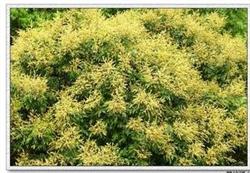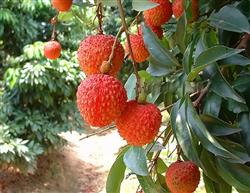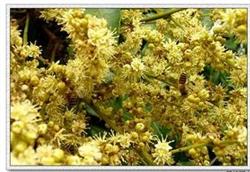Careful retting of litchi and longan in rainy days

At present, the main work is to prevent "sprouting", improve the quality of flower ears, pay attention to the occurrence of diseases and insect pests, and fertilize in time the weather of high temperature and high humidity in February, which causes "sprouting" in many litchi and longan orchards, which has a great influence on the quality of buds and flowers. low temperature and rain in the early stage has an effect on the late development of flower buds and the prevention of "flushing". However, after the recent rain, the rise in temperature is disadvantageous to the flower ear growth of litchi, longan and other southern fruit trees. Generally speaking, as long as there is low temperature in the budding stage and the plant is growing again, it is possible to pull out the flower ear. At present, the main work is to prevent "flushing", improve the quality of flowers and ears, pay attention to the occurrence of diseases and insect pests, and apply fertilizer in time. Early-maturing litchi: early-maturing litchi varieties such as March Red and White Sugar are in flowering and young fruit growth period. Pay attention to the occurrence of retting flowers and diseases and insect pests on rainy days. Key points of current management: ① prevents retting. Precocious litchi has large spikes and many buds. If it blossoms and meets rain, its residual flowers and nectar will form a good culture ground for pathogens, which is disadvantageous to the development of young fruits of female flowers. Therefore, it is necessary to shake the trees in time after the rain, shake off the residual flowers and Rain Water, so that the ears of flowers can be ventilated and transparent, which is good for the growth of young fruits. ② spray to control diseases and insect pests. High temperature and humidity weather is easy to induce diseases, especially in low-border orchards, you can spray some disease-preventing pesticides at the early stage of flowering or during flowering. ③ supplemented nutrients to increase the fruit setting rate. Early-maturing litchi has large panicles, many buds and consumes more nutrients during flowering, so spraying 1-Mu agricultural nucleotides or cyan cytokinins twice when the female flowers are just shedding, replenishing nutrients and a small amount of hormones in time is helpful to fruit setting. ④ spray to protect fruit. The fruit was sprayed once every 10 days after the female flower was withered. ⑤ fertilization. Apply appropriate amount of compound fertilizer or organic fertilizer according to the amount of flowers and fruits. Mid-ripe litchi: fertilizing and replenishing nutrients Shuidong, Heiye, Feizixiao and other mid-ripe litchi varieties are in the flowering and early flowering stage. Pay attention to the excessive growth of flower ears, do a good job of flower thinning, control diseases and insect pests, and fertilize to replenish nutrients. Key points of current management: ① prevents flower spikes from overgrowing, mainly for trees that have flowering ears recently. Rain is beneficial to the growth of flower spikes. When the length of flower ear reaches 5mur8 cm, it can be sprayed once (30 kg of water in each packet) to control the growth rate of flower ear and reduce the number of flowers. When the flower spike is more than 8 cm, the spray concentration is higher (20 kg of water per packet). ② flower thinning, mainly aimed at Feizixiao varieties. Feizi smile is easier to grow into flowers, but because of too many flowers, there is often a phenomenon of "flowers but not real", so it is necessary to improve its fruit setting rate by thinning flowers. Generally speaking, Feizixiao keeps about 200 per panicle and sets high fruit. When the first batch of young fruit begins to grow, it removes the other buds that have not yet bloomed, and the fruit setting is also very high. The former is also operable, while the latter is more difficult to operate, because it is very difficult to sparse flowers when flowers and fruits are mixed together. It is best to carry out flower thinning before the panicle is fully extended or before flowering, which can reduce nutrient consumption and facilitate fruit setting. ③ supplemented nutrients to improve fruit setting. The male flower consumes too much nutrients when it blooms, which affects the growth of young fruit. When the female flower is just shedding, it should be sprayed immediately for two times with agricultural nucleotides or cyan cytokinins to supplement nutrients and hormones, which can improve fruit setting. Especially in the higher temperature producing areas such as Hainan Island and western Guangdong, because of the temperature, the flowers of Kaohsiung are concentrated and fast when they bloom, and the nutrient consumption is more. Therefore, the effect of replenishing nutrients immediately after female flowers is more obvious than spraying in the later stage to protect fruit. ④ fertilization. In the early stage, due to the lack of water, it is difficult to fertilize the soil, so we should take advantage of the rain to apply fertilizer, mainly compound fertilizer and organic fertilizer, and weak trees should apply appropriate amount of nitrogen fertilizer. ⑤ should pay attention to the occurrence of diseases and insect pests and control them by spraying in time. Late ripening litchi: controlling the length of flower ear Nuomi, Guiwei, Huaizhi and other late ripening litchi varieties are in the budding stage and flowering stage. Pay attention to prevent the "rush" and spikes of flowers from growing, and cultivate robust spikes of flowers. At present, the growth state is different in different shoot stages. the trees with early shoot control begin to blossom in late January and begin to blossom in early February, with a small amount of "sprouting"; the autumn shoots that came out in the middle and late of last October began to blossom recently, and began to blossom after rain; the autumn shoots that came out later also saw flowers early, but turned into buds with the increase of temperature. Current management point: ① prevents "flushing". For the ear of flowers with leaves, if the leaves have stopped growing, there is no need to treat them. Trees whose leaves are still growing should be sprayed immediately with 40 kg of water in each packet, forcing the leaves to stop growing and concentrate nutrients on the heading of flowers. Guiwei and Huai branches will appear flower spikes with leaves, and there is no need to pick leaves; glutinous rice will produce flower ears on the new shoots, and the buds are weak, so they should be properly sprayed twice with agricultural nucleotides or cyan cytokinins. ② spray controls the spike length and cultivates robust buds. The spikes of flowers extracted at high temperature had long internodes and weak buds and lower fruit setting. When the flower spike is exposed to high temperature, it is necessary to spray and control the length. The results show that the flower ear of glutinous rice is better when it is about 10 cm. The flower spike can be sprayed about 5 cm (30 kg of water in each packet) to shorten the length of the flower ear. ③ cultivates robust flower spikes, mainly for trees with late budding. The temperature rises faster in spring, and the later the flower buds are, the less guaranteed the flower quality is. In order to improve the fruit setting rate of late flowers, agricultural nucleotides or cyan cytokinins + 0.2% potassium dihydrogen phosphate were sprayed during flower ear growth. ④ spray to prevent diseases and insect pests. As the temperature picks up and it rains, overwintering diseases and insects begin to move. If the orchard disease is serious, some disease-preventing pesticides should be sprayed at the budding stage and the early flowering stage. The orchard with a large number of stink bugs can spray 90% trichlorfon 800ml 1000 times at a time. When felt disease occurs, first cut off the diseased leaves, move them out of the orchard and burn them, and then spray mites with pesticides. When spraying, focus on spraying leaf back and inner chamber branches and leaves. ⑤ fertilization. Well-managed orchards were fertilized as early as January, while some unmanaged orchards can be fertilized at the budding stage. In orchards with insufficient base fertilizer, organic fertilizer should be added in addition to compound fertilizer. Longan: pay attention to prevent the shoot longan is in the budding stage. Pay attention to prevent "flushing", fertilize strong flowers and spikes. The low temperature and heavy rain in January this year is very beneficial to the spikes of longan flowers on Hainan Island. As long as the autumn shoots are timely, the spikes are basically out in time, and the spikes grow normally. Only part of the out-of-season orchards show "rush" in buds when the temperature is high in January. In the orchard near Guangzhou where flowering began in late January, although there were leaflets growing at a high temperature in February, they quickly turned green and could still produce flowering spikes. However, under the influence of high temperature, the trees that saw blooming spots in the first and middle of February all grew into spring shoots and began to turn green. If the temperature drops from late February to early March, longan can still produce flowers on the new shoots. Current management point: ① prevents "flushing". In fact, the key to whether there is a "rush" in longan lies in the atmospheric temperature. Because when the temperature is higher than 15 ℃ and the humidity is more than 70%, the leaf grows faster than the flower ear, and even if the flower ear can be produced, the fruit setting will be affected. At present, there is no technology to control the temperature, only some measures can be taken to control the growth of leaves. In the process of flower bud differentiation, leaves differentiate at the same time, but it is affected by air temperature in the process of growth. In the near future, there will be weak cold air to the south, there will be a "rush" of the orchard, the top priority is to force the leaves to stop growing and pull out the ears of flowers. Orchards with new shoots should be sprayed immediately (30 kg of water in each packet) to force leaves to stop growing and strive for spikes to grow. If the leaf is stiff or starts to turn green, do not deal with it. ② fertilization. Pay attention to control the application of nitrogen fertilizer, unless the tree is weak, generally do not apply nitrogen fertilizer, because nitrogen fertilizer will promote leaf growth. Fertilization is mainly compound fertilizer and organic fertilizer, if the base fertilizer is sufficient, only an appropriate amount of compound fertilizer is applied. ③ prevents spikes from overgrowing. The results show that the flower ear length of longan is about 25 cm in Shixia. Therefore, when the flower spike is about 10 cm, the spray control tip intelligently controls the flower ear length, which is beneficial to fruit setting. ④ spray to control diseases and insect pests. In spring, longan horned wood lice damage new leaves, stink bugs damage flower ears, litchi gall mites damage leaves and flowers, so timely spraying should be used to control insect pests. ⑤ thinning branches and clearing the garden. Shady orchards can carry out appropriate thinning in the bud stage, mainly to remove shady branches, drooping branches, weak branches and branches damaged by diseases and insect pests, remove orchard weeds and reduce the occurrence of diseases and insect pests.
- Prev

Key points of Management of Litchi Longan fruiting trees
First, do a good job of postharvest management. 1. Timely harvest. When picking fruit, one fruit should be cut twice. First, cut the ear together with the base of the fruiting branch, or even the base of the branch below the fruiting branch, and then cut off the ear. The branches below the ear do not shrink much, depending on the growth of the mother branch, and the ones that grow well are shortened.
- Next

Dealing with Rain Water's continuous management methods of litchi and longan
Longan blossoms in continuous rainy weather, the anther does not crack, it is difficult to pollinate and fertilize, and the flowers bloom in piles, resulting in rotten flowers, no fruit or unsatisfactory results. Yuhualing technology here reminds fruit growers to pay attention to prevent retting. 1. Do a good job in flower thinning. The flower spike is short, the lateral flower ear is many, the flower bud is dense, need to carry on before flowering.
Related
- Moge, come on! The staff of the peasant association in the producing area of cantaloupe were frightened when the crowd gathered.
- Causes and Solutions of low Fruit setting rate of Apple
- Symptoms and control measures of passion fruit virus disease
- Fruit growing lesson: how do apple orchards keep high yields?
- Can you build orchards in the mountains? What are the pros and cons?
- How to manage the coloring period of Crisson grape?
- This paper introduces the processing technology of two kinds of fig products.
- How much is a month for retired teachers in rural areas by 2020?
- How can strawberry planting increase sugar content? We should pay attention to management in many aspects.
- What are the cultivation techniques on how to improve the yield of golden fruit?

